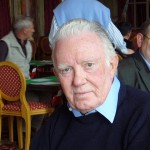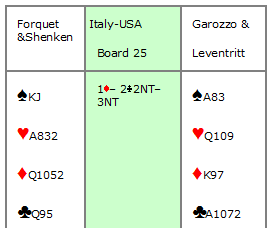leer en español » leggi in italiano »
 1. Ice self-control. The ACBL’s Official Encyclopedia writes on you: “…Known for calm, unruffled appearance, apparently immune to the nervousness that afflicted many other top stars…” At Stokholm 1956 European championship, indeed, your calm gave the victory to Italy. In the final match, against France, Roger Trezel doubled your 7♠. It was makeable, but Guglielmo Siniscalco, then your partner, switched to 7NT, also doubled but no longer makeable: the heart control was by void, and a six heart trick parade marched undisturbed trough the table.
1. Ice self-control. The ACBL’s Official Encyclopedia writes on you: “…Known for calm, unruffled appearance, apparently immune to the nervousness that afflicted many other top stars…” At Stokholm 1956 European championship, indeed, your calm gave the victory to Italy. In the final match, against France, Roger Trezel doubled your 7♠. It was makeable, but Guglielmo Siniscalco, then your partner, switched to 7NT, also doubled but no longer makeable: the heart control was by void, and a six heart trick parade marched undisturbed trough the table.
You followed to play “…Placidly…and this proof of excellent temperament allowed Siniscalco to recover…” (Carl’Alberto Perroux – “Il Blue Team nella storia del Bridge”, pag. 68. Mursia 1973).
Your temperament however is far from seraphic. How do you obtain such self control at the table?
At the table it always need retain the calm. We know and appreciate our partner, otherwise we wouldn’t play together, and we know that everyone happens to make mistakes. Supposing that my temperament is “far from seraphic”, it means that at the table I can control myself.
2. A saucy reply. Many think that the HUM (High Unusual Method) should be ruled or utterly forbidden. They say: “Why should I study what others do even if it is wrong?”.
Carl’Alberto Perroux, then Blue Team’s Captain, instead advised to study opponents’ devices. Someone replied him that he hadn’t time to study his own system, let alone others! Who did give such cheeky reply? You, maybe? What’s your viewpoint about?
In the fine old times it needn’t study opponents’ systems. It was almost all natural. Today, with the relais, the conventional responses, the transfers, and thousands of gadgets it would be essentialto always have a good coach who studies the conventions of the adversaries and prepares apt countermeasures.
3. The new entry. Work commitments forced Guglielmo Siniscalco to give up bridge playing in 1961; he had borne to Italy three Bermuda Bowl and four European titles. He was replaced by Benito Garozzo, Neapolitan as you, Siniscalco, and Chiaradia. The pair Forquet-Garozzo has been maybe the strongest one of all time (as stated by Time Magazine in 1997).
This was that wonderful sextet: D’Alelio-Chiaradia, Forquet-Garozzo, Belladonna-Avarelli. And here is what Henry Francis and Brian Senior write, on Buenos Aires 1961, in “The all time Bermuda Bowl best deals” [1999 Five aces books, Wycombe, En. Pag. 69]:
“…Spectators would not have needed a crystal ball to foresee Italy’s domination of the event throughout the coming years.”
Did you foresee it too? Which is the best quality of Garozzo as partner? Which is the worst flaw?
Garozzo has been the best in bidding as in playing. His flaw? He always changed the system…
4. Constructive weak openings. Francis and Senior also noted the Italian philosophy toward pre-emptive openings: semi-constructive rather than purely destructive. Indeed, in Neapolitan Club the weak 2’s openings are in the range 7-12. What are the advantages? Do you think that the constructive treatment could be used in today bridge too?
Over time our barrages aren’t longer semi-constructive as it was.
5. Double doubt. 1st doubt: Support Double. South opens 1♦, North replies 1♥, East overcalls 1♠. The South’s double, now, would show a three card support in hearts. This is the Eric Rodwell’s support double:
http://www.bridgetopics.com/topics-collection
Why do play it? Why do not?
We use this double for showing a good hand, not linked to the support.
6. Double doubt. 2nd doubt: Takeout double. Michael Lawrence says that the “perfect hand” for the takeout double is a 4441, and that with such shape eleven HCP are enough for enter any opening at level one. South has opened 1♥; as West, Lawrence doubles with:
♠A1094 ♥6 ♦K982 ♣K1094. Ten HCP by heads and with “body”. Are enough for you?
Having: ♠6 ♥A1094 ♦K982 ♣K1094, and being vulnerable, would you double an opening of 1♠? We have submitted these hands to several players: http://neapolitanclub.altervista.org/eng/the-perfect-hand-for-takeout-double.html
Complete agreement in both the first and second example.
7. Pietro, what on earth is the system we are playing?! The Forquet-Garozzo’s System, Blue Team Club, was published in 1967. In that edition it was a sound system as the Chiaradia’s Neapolitan Club, both with 4CM, preparedness principle and punitive double on West’s overcalling. When did you start to play it? Let’s open again “Bermuda Bowl best deals”: there is a strange auction from 1965 Buenos Aires.

The book only reports this hand because the different defence: you made 3NT whereas at the other table the Avarelli’s lead defeated Shenken. The auction was identical in both tables; it looks a normal standard, but it was normal for Americans, not for Italians. The Neapolitan Club never allowed this bidding, nor did the 1967’s edition of Blue Team Club.
In both systems, indeed, you should pass: there are only two defensive tricks, the honours are scattered, and the ♣Q is poorly guarded. Being you forced to open, for example needing an odd result (but Italy led), you should have bidden 1♥: hearts are stronger than diamonds and, anyway, it’s a major suit. Furthermore, opening 1♥ you were prepared to the reply 2♣: you could have bidden 2♦ because the preparedness principle overlooks the long-short convention. Finally, your 2NT on Garozzo’s 2♣ showed a good 13 or 14 HCP hand.
Was it an undisciplined opening, maybe? Which system did you play in 1965 with Garozzo?
I do not see anything odd in this sequence. Hearts followed by diamonds showed at least nine cards and was ambiguous. 2NT was passable. Today we have a little “naturalized” the sequences (where the clubs are not involved) of the opener and the responder.
8. Chiaradia. Carl’Alberto Perroux, the Captain, left Eugenio Chiaradia out in 1964 Olympic games. That new team won that title and much other in the following years. They were: D’Alelio-Pabis Ticci, Forquet-Garozzo, Belladonna-Avarelli.
Said in this terms, it appears as a simple substitution of Chiaradia by Camillo Pabis Ticci, but the things were more complex. It need to know, at least, that Mimmo D’Alelio, former Chiaradia’s partner, started to play Roman Club with Belladonna and Avarelli, then in 1963 the Team wasn’t longer made by three pairs but by two threesomes. Your one was with Garozzo and Chiaradia, but in the last times you and the latter were “…Made right for being parted…”, as Perroux wrote in his book.
Is there other that we don’t know? Can you fill the empty spaces?
Eugenio Chiaradia was great and was the first to make a change to the bridge that was played once. Unfortunately, he was too emotive at table. “…Made right for being parted…” is only an Alberto’s witty remark…
9. Carl’Alberto Perroux. In his book, the Captain didn’t hide a deep affection for you. Can you sketch a portrait of him?
Perroux was a master in holding up the balance of the team. It’s true that there was a great friendship in the team, but it is also true that occasionally some small gear needed to be greased.
***
by Paolo Enrico Garrisi
(Thanks to Claire Martel for the photo: Pietro Forquet at Deauville Bridge Festival 2007)